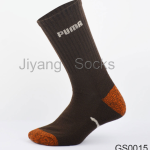Minimum Sock Height
SHmin = 9Q(h/1.67)2+(h-1.67)
An example: for a person of 1.67m and Q=1, we will have a SHmin of 9cm.
Solving for CLmin is easy. The int refers to the mathematical integer. If your result is 10.77,
round up to 11cm.
CLmin=int(SHmin*(5/9))
Using our SHmin of 9cm, we get a CLmin of 5cm, or, 2 inches.
If you don¡¯t want to know the SHmin, you can calculate CLmin thusly:
CLmin=5Q(h/1.67)2+(h-1.67)
For a height of 1.67m, and Q=1, we get 5cm.
Maximum Sock Height
SHmax = 13Q(h/1.67)2+(h-1.67)
Using our hypothetical person of 1.67m and Q=1, we get 13.5cm.
Maximum sock cuff is solved for thus:
CLmax=int(SHmax*(20/27)).
This gives us 10cm for CLmax, using h=1.67, Q=1 and SHmax=13.5.
If you don¡¯t want to know the SHmax, you can calculate CLmax thusly:
CLmax=10Q(h/1.67)2+(h-1.67)
Now, these calculations are fairly accurate, but your mileage may vary. What they
do give you is a starting point to optimise your sock height to address any performance issues.
Ignoring these guidelines can lead to broken feet (referred to as sock-sickness), a general disposition to being a slower rider, and ridicule from non crit-riders (though any ridicule foisted upon you by a short-sock-wearing triathlete is to be denigrated appropriately).




